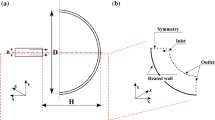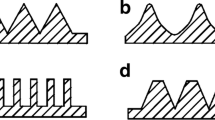Abstract
The surface accuracy and quality of the mirror blank determine the performance of the optical mirror, so it is essential to explore a simple and effective way to process the mirror blank. Gas jet forming is a simple and efficient way of forming optical surfaces. However, the key to accurately forming mirror blanks is establishing the relationship between the gas jet parameters and the resulting surface shape. Therefore, several experiments were carried out in this study to develop the relevant models to investigate the above issues. The experimental data analysis found that the surface tension of the viscous fluid being processed impacts the shape of the surface formed by the gas jet. Therefore, the new model for predicting the surface shape of gas jets was developed by refining the Blanks and Chandrasekhara model by adding surface tension. The prediction error of the new model for the depth of the surface formed by the gas jet is in the range of 0.0497–0.833 mm, much smaller than the uncorrected model.












Similar content being viewed by others
Data availability
The authors confirm that the data supporting the findings of this study are available within the article.
References
Jedamzik R, Werner T, Westerhoff T (2014) Production of the 426 m ZERODUR mirror blank for the advanced technology solar telescope (ATST). Proc SPIE 9151:311–319
Yang HS, Kang P (2017) New bending system using a segmented vacuum chuck for stressed mirror polishing of thin mirrors. Curr Opt Photon 1:618–625
Westerhoff T, Schäfer M, Thomas A, Weissenburger M, Werner T, Werz A (2010) Manufacturing of the ZERODUR 1.5-m primary mirror for the solar telescope GREGOR as preparation of light weighting of blanks up to 4-m diameter. Proc Spie 7739 77390M-77390M-9
Saito TT, Esposito RR, Johnson FE (1978) Adherent dielectric coating of diamond-turned mirrors. Opt Lett 2:19–21
Seo H, Han JY, Kim SW, Seong S, Yoon S, Lee K, Hong J, Lee H, Bok M (2016) Novel orthogonal velocity polishing tool and its material removal characteristics from CVD SiC mirror surfaces. Opt Express 24:12349–12366
Yi AY, Li L (2005) Design and fabrication of a microlens array by use of a slow tool servo. Opt Lett 30:1707–1709
Yan G, Zhang Y, You K, Li Z, Yuan Y, Fang F (2019) Off-spindle-axis spiral grinding of aspheric microlens array mold inserts. Opt Express 27:10873–10889
Chkhalo NI, Churin SA, Pestov AE, Salashchenko NN, Vainer YA, Zorina MV (2014) Roughness measurement and ion-beam polishing of super-smooth optical surfaces of fused quartz and optical ceramics. Opt Express 22:20094–20106
Parks RE (1993) Book Rvw: fabrication methods for precision optics By Hank H Karow. Opt Eng 32:2624–2625
Yi AY, Jain A (2005) Compression molding of aspherical glass lenses-a combined experimental and numerical analysis. J Am Ceram Soc 88:579–586
Ristok S, Roeder M, Thiele S, Hentschel M, Guenther T, Zimmermann A, Herkommer AM, Giessen H (2020) Mass-producible micro-optical elements by injection compression molding and focused ion beam structured titanium molding tools. Opt Lett 45:1184–1187
Zhang L, Zhou W, Yi AY (2017) Rapid localized heating of graphene coating on a silicon mold by induction for precision molding of polymer optics. Opt Lett 42:1369–1372
Bhat P, Merotte J, Simacek P, Advani SG (2009) Process analysis of compression resin transfer molding. Compos Part A Appl Sci Manuf 40:431–441
Fang C, Xu J, Zhao H, Li W, Liu H (2015) Experimental investigation on particle entrainment behaviors near a nozzle in gas-particle coaxial jets. Powder Technol 286:55–63
Tian X, Zhao H, Liu H, Li W, Xu J (2014) Liquid entrainment behavior at the nozzle exit in coaxial gas-liquid jets. Chem Eng Sci 107:93–101
Williams TJ, Ali MRMH, Anderson JS (1969) Noise and flow characteristics of coaxial jets. Arch J Mech Eng Sci 11:133–142
Banks RB, Chandrasekhara DV (1963) Experimental investigation of the penetration of a high-velocity gas jet through a liquid surface. J Fluid Mech 15:13–34
Cheslak FR (1969) Cavities formed on liquid surfaces by impinging gaseous jets. J Fluid Mech 36:55–63
Hwang HY, Irons GA (2011) Mathematical modeling of impinging gas jets on liquid surfaces. Metall and Mater Trans B 42:575–591
Li MM, Li Q, Li L, He YB, Zou ZS (2014) Effect of operation parameters on supersonic jet behaviour of BOF six-nozzle oxygen lance. Ironmaking Steelmaking 41:699–709
Funding
This work was supported by the Basic and Applied Basic Research Fund of Guangdong Province (2021A1515110927); Jilin Province Scientific and Technological Development Program (20200201006JC); The Open Project Program of Key Laboratory for Cross-Scale Micro and Nano Manufacturing, Ministry of Education, Changchun University of Science and Technology (CMNM-KF202108); and Scientific Research Project of Education Department of Guangdong Province (2022KCXTD029).
Author information
Authors and Affiliations
Contributions
Weijie Fu: conceptualisation, methodology, software, investigation, and writing—original draft. Weiwen Jiang: validation, formal analysis, visualisation, and software. Xinming Zhang: validation, formal analysis, visualisation, and investigation.
Corresponding author
Ethics declarations
Ethics approval
The author obliged all the rules regarding the ethics in publication.
Consent to participate
All the authors consent regarding the data provided in the text as well as the order of authorship.
Consent for publication
All the authors consent regarding publication immediately after acceptance.
Conflict of interest
The authors declare no competing interests.
Additional information
Publisher's note
Springer Nature remains neutral with regard to jurisdictional claims in published maps and institutional affiliations.
Rights and permissions
Springer Nature or its licensor (e.g. a society or other partner) holds exclusive rights to this article under a publishing agreement with the author(s) or other rightsholder(s); author self-archiving of the accepted manuscript version of this article is solely governed by the terms of such publishing agreement and applicable law.
About this article
Cite this article
Fu, W., Jiang, W. & Zhang, X. Calculation model of the concave mirror depth in gas jet forming of the mirror blank. Int J Adv Manuf Technol 125, 1679–1687 (2023). https://doi.org/10.1007/s00170-023-10842-2
Received:
Accepted:
Published:
Issue Date:
DOI: https://doi.org/10.1007/s00170-023-10842-2




